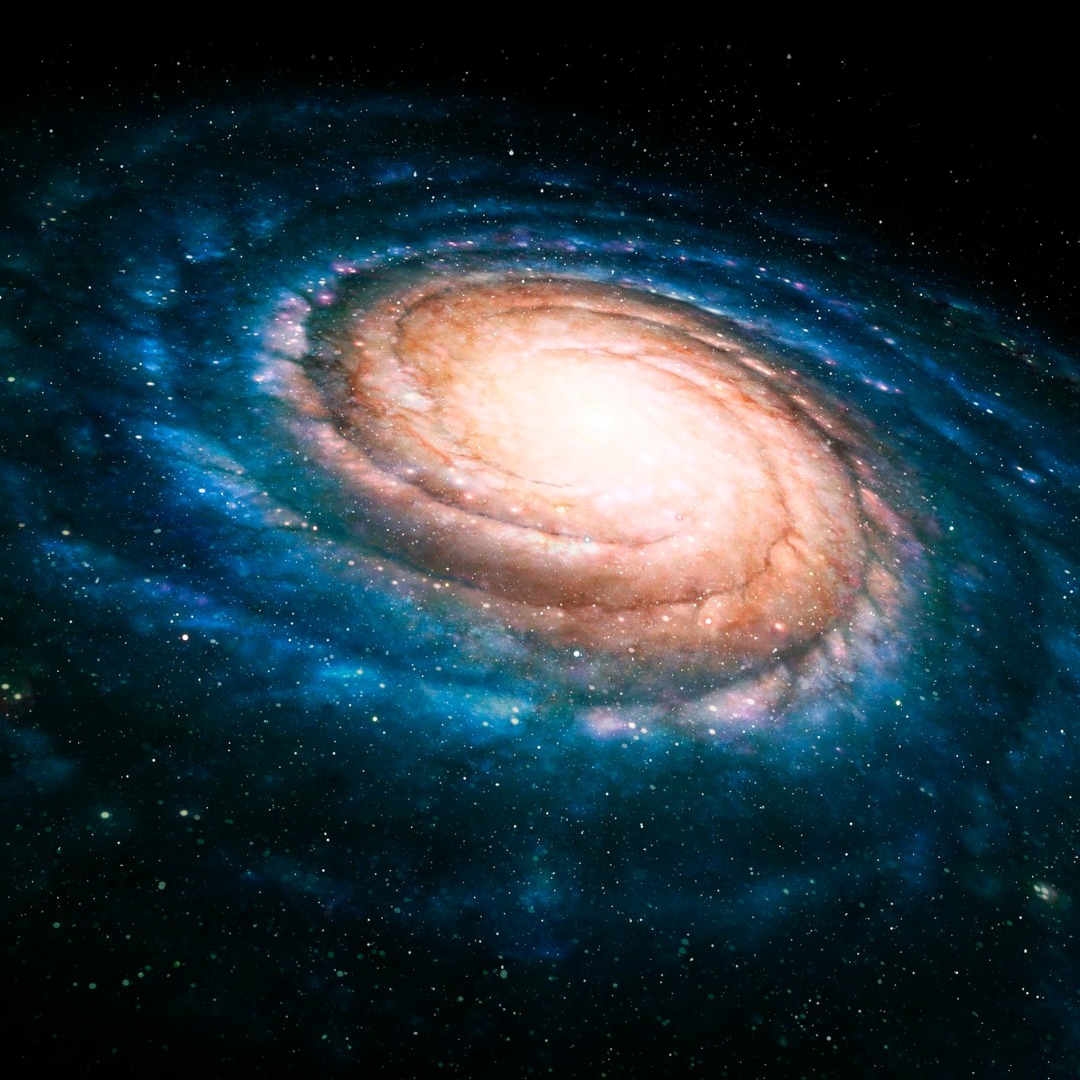
Evolution of the Universe
~15 min read
|
Table of Contents |
This article explains how scientists are able to visualize extremely large and extremely small distances and times by using logarithms. The numbers become much more like numbers we are used to. In a four-part series, different aspects of the problem are portrayed to show how it’s done.
Part 1 - Evolution of the Universe
In the current Standard Model of Cosmology, it all seems to start from a small, hot dense plasma, followed by an inflationary expansion of incredible speed. The primordial “fireball” fills all space and it is space itself that expands faster than the speed of light. This phase occurs in the first 10-32 seconds after the Big Bang.

The graph of the evolution of the universe is shaped like a bell on its side, with the time axis going from left to right. This is a linear plot, not a log plot. It shows up different features from the logarithmic timeline for creation. This graph is a two-dimensional representation of a process that happened in four dimensions. Each gradation on the time scale (horizontal axis) is a billion years.
As space expands, it is filled with more and more energy. Eventually (still within the first second) the expansion slows down and the universe starts to cool. At this point it is still a region of incredibly high energy density, too hot for the formation of even fundamental subatomic particles, let alone nucleons (protons and neutrons) and nuclei. As the temperature drops, neutrons and protons are able to form without being immediately turned back into energy. This occurs between the first microsecond and the end of the first second.
As the temperature decreases, it reaches a point at which neutral atoms form. Photons are able to pass through the neutral atoms and travel essentially unimpeded through the universe. These photons survive today as the Cosmic Microwave Background (CMB) radiation that permeates the universe in a rather uniform bath of photons that have red-shifted to very low energy by the expansion of space. In the days of broadcast television, at least part of the random noise that showed up on the television screen after the stations stop broadcasting, was caused by this microwave background, so many of us have actually seen this remnant of the Big Bang on our televisions. It was the discovery of this CMB radiation that finally allowed the Big Bang Theory to dominate over the Steady State Theory, in 1964. The current understanding of the history of the universe is quite recent, within a single human lifetime (including the writer’s).
As the universe expands, gravity slows down the expansion, as expected since gravity is always attractive. But then something unexpected occurs at about the twelve-billion-year mark. Instead of the expansion slowing down, it begins to speed up. In the era in which we live, gravity is not the dominant force in the universe (if gravity is actually a force…Einstein might have something to say about that). Something else takes over and the expansion of the universe starts to speed up again. The cause of this force is unknown, and its impact is huge, enough to speed up the whole universe. Some call this Dark Energy, for lack of a better term.
At about the twelve-billion-year point, two important things happen: the expansion of the universe starts to speed up again, and the solar system forms in the Milky Way Galaxy. While no one thinks these events are correlated, the coincidence is remarkable. (Some people say there are no coincidences.) The implications for future civilizations in other galaxies are profound. The universe will continue to expand and eventually the galaxies will be so spread out in space that they will not see one another, and all galaxies will think they are alone in the universe. The Cosmic Microwave Background will redshift and dilute to the point that it is undetectable so there will be no evidence of the early state of the universe. Inhabitants of that civilization will think the universe had no beginning and that they are alone in it.
We live in an era in the evolution of the universe when we can still see evidence of the start of the universe, and we can still see other galaxies. Our perspective may well be unique among civilizations.
Part 2 - Scientific Notation
In day-to-day life we don’t deal with the immense distances in intergalactic space, with the vanishingly small distances in subatomic particles or the immense durations of cosmic evolution. Our daily experiences have us thinking in a very linear fashion and this does not equip us for these extreme numbers. Astronomers and particle physicists deal with these numbers all the time. Scientists in general have developed systems to deal with very large and very small numbers in a way that lets them visualize them. This involves using exponentials.
If we want to write the number ten thousand, we write 10,000. We have to count the zeros to read the number. This can be simplified by realizing that 10,000 is the product of four tens multiplied together. This is simplified to 104, which is shorthand for four tens multiplied together. This is an exponential format. If we want to write the number 23 thousand and 700, thus could be simplified to 2.37*104. (We use * to denote multiplication rather than “x” to avoid confusion…it worked in Fortran programs, and it’ll work here too. What is Fortran? We should talk.) This format is called standard scientific notation. By convention, the number ahead of the decimal point is between 1 and 10.
Similarly, extremely small numbers can be written in an analogous format. Instead of writing one ten thousandth, recognize that 1 divided by 10 four times gives one ten thousandth. This is simplified to 10-4, where the negative sign in the exponent signifies divided by. 2.37*10 -4 represents 2.37 ten thousandths, a very small number.
The distance to the nearest major city (Ottawa) is 200 km, or 200,000 metres. This is simplified to 2*105 m. The distance to the Moon is 384,000 km or 384,000,000 m. This becomes 3.84*108 m. At a glance we see that the Moon is about 103 (a thousand) times farther than the closest major city. When dividing exponentials, subtract exponents (8–5=3). This is the advantage of exponents. The sun is 147 million km from Earth. This can be expressed as 1.47*1011 m, about 106 times farther than our nearest city. Using very concise terms, we have described numbers that vary in size by a factor of 106 (a million) without having to count zeros. To make it even more dramatic, the distance to galaxy M31 in the constellation Andromeda is 2.4*1022 m. The Andromeda galaxy is about 1017 times farther than the closest city (22–5=17).
We have been able to talk about astronomical distances and even directly compare them to terrestrial distances, without a lot of math or the need to count a lot of zeros, just add and subtract simple integers contained in exponents.
It is a similar exercise to look at very small distances. An atom is about 10-10 metres across. That means a metre stick is as long as ten trillion atoms sitting side by side. A proton, one of the constituents of an atomic nucleus, is about 10-15 metres across. That means an atom is 10-10/10-15, or 105 times wider than a proton, one hundred thousand times wider. (When dividing exponentials, subtract exponents, another handy feature.)
We have been doing some pretty sophisticated math comparing things with vastly different sizes just by moving some exponents around. The technique is very powerful and will suit us well when discussing cosmology, subatomic particles and even probabilities, when discussing chances of life forming.
Representing these numbers in the form of a graph is still tricky because they are vastly different in size. To do this, we need to look at logarithms.
Part 3 - Logarithms
Even when quantities are expressed in scientific notation, they can still exist in a huge range of magnitudes. Events can occur in very different time or distance scales. The Big Bang happened in an instant of time, probably less than a second, but the evolution of the universe takes place over billions of years. Many events happen in a very short period, followed by many events happening over very long periods of time. We need a method of observing these events in a coherent manner. One way to do this is with logarithms. A logarithm (usually shortened to log) is the opposite process to exponentiation. If a number is given by A*10n, then the log of the number is n*log(A). The log of a number is the power ten must be raised to give back the number. If the number is 1,000 then the log of the number is 3, because 103=1,000. It sounds like a trick, but it can make things a lot clearer. One useful rule of logs is the log of a product A*B is the sum of the logs, log(A)+log(B).
Remember that numbers in scientific notation are of the form A*10n where A is number describing a measurement (a numerical value) and n is an exponent giving the order of magnitude. By taking the logarithm of this number we get n*log(A) (by the rule above). Remember also that A is a number between 1 and 10, by convention. The log of a number in scientific notation is the exponent (power of 10) plus the log of a number between 1 and 10. The log of 1 is zero and the log of 10 is 1, so the log of a number in scientific notation is the exponent of 10 plus a little bit.
Now go back to the example distances when we first introduced scientific notation. The distance to Ottawa was 2*105 m, the distance to the Moon was 3.84*108 m, the distance to the Sun was 1.47*1011 m and the distance to the galaxy in Andromeda was 2.4*1022 m. If we instead use logs, these distances become 5*log(2)=5.30, 8*log(3.84)=8.58, 11*log(1.47)=11.17 and 22*log(2.4)=22.38. Instead of comparing huge numbers, we are comparing 5.30 (Ottawa), 8.58 (Moon), 11.17 (Sun) and 22.38 (Andromeda). In each case, the log of the number is not much different from the exponent of 10. No information has been lost; we just take the exponential to get back the actual distances. But if we plot the logs rather than the exponential form, it all fits on a graph with the numbers well-spaced out. Vastly different numbers become very comparable and easier to visualize.
What we can do now is a logarithmic plot of our data. This can be done by plotting the logs, but an alternative is to use log graph paper (in the days of using paper). In normal linear graph paper, all the lines forming the graph are spaced equidistant on the page. In log paper, the separation of the lines is proportional to the log.
This can be made clearer by looking at an example. We’ll use the plot of the Timeline of Creation using logs.
Part 4 - Timeline of Creation Using Logs

The standard model of cosmology starts with a Big Bang. In the beginning the universe is extremely small and has extremely high density. The curvature of space is so extreme and the pressure exerted on the fabric of space is so large that it expands at speeds in excess of the speed of light (matter can’t move at the speed of light, but space can). In the initial fraction of a second the size of the universe increases from sub-atomic to many lightyears across. This inflationary stage lasts about 10-32 seconds. The initial temperature is too high for subatomic particles to form and the universe is filled with energy. As the universe expends, the temperature drops and matter begins to form from the energy. Quarks form in the first 10-12 seconds, baryons in the first 10-6 seconds, neutrons and protons in the first second and electrons in the first ten seconds. As the temperature continues to drop, condensation and organization become the dominant activities in the universe.
In the first 400 thousand years, all matter is ionized and photons are readily absorbed and scattered. Light cannot travel very far before being absorbed and the universe is opaque. When the universe is cool enough to form neutral atoms, photons are free to travel large distances before interacting with matter. This marks the start of the “dark ages.”
With the formation of the first stars after 500 million years, light comes back into the universe. Galaxies and stellar clusters form after 800 million years. Some of the original stars go through their life cycle creating heavier elements and then explode by various processes, like supernovae, and send heavy nuclei into the galaxy to form second generation stars and their planetary systems.
Eventually, after about nine billion years, is the formation of the Sun and the Solar System, including Earth. From this point on, the interesting evolution continues on the surface of Earth.
The initial moments of the universe have a rapid sequence of events that create the original matter, but the pace slows down considerably as stars and galaxies are formed. The pace starts to pick up again on Earth once life forms and evolution takes off. The pace of evolution goes faster and faster as we near the current time.
Once life forms, it goes on to cover the face of the planet with amazing diversity. The starting point seems to be RNA molecules, then cells, multicellular beings, vertebrates, land animals, mammals, placental mammals, primates, apes and hominids. The last surviving hominids are Homo sapiens. This evolutionary arc covers about four billion years. It is only one of so very many evolutionary arcs, each of which ends in a species of animal or plant that lives on Earth today.
Placing this information in a plot presents a struggle of axes. The issue is things start out very fast but then slow down as the universe settles into star and galaxy formation, much slower processes. Once the surface of Earth cools enough to enable complex chemistry, the pace picks up again. Getting all this to fit on one axis is a daunting task. Let’s imagine there is not one axis but two. The first axis starts at the Big Bang and proceeds out to the formation of Earth. This takes about 104 million years. We can take our unit of time as millions of years (mega-years, if you will). Since the numbers are huge and the size varies so much, let’s plot the log of the time rather than the time itself. We can do this either by taking logs of all the numbers, or we can plot the data on a logarithmic plot. This is what we have done here. Using the log scale, we can show the rapid processes and the slow ones on comparable scales on the plot.
But things change dramatically on Earth once evolution picks up. Here it is convenient to measure time in the reverse direction. Starting at the present time, we can move backwards in time to when Earth cooled down to a temperature at which life could form, about four billion years ago.
Using this curious dual-log axis, we can capture the rate of stellar formation as well the rate of the evolution of life on Earth. And it’s all on one axis and we can label it all in an easy-to-read format.
This plot, in conjunction with a plot of the evolution of the universe can tell us something about the Cosmic environment surrounding Earth and some of the remarkable features of the Cosmos.


